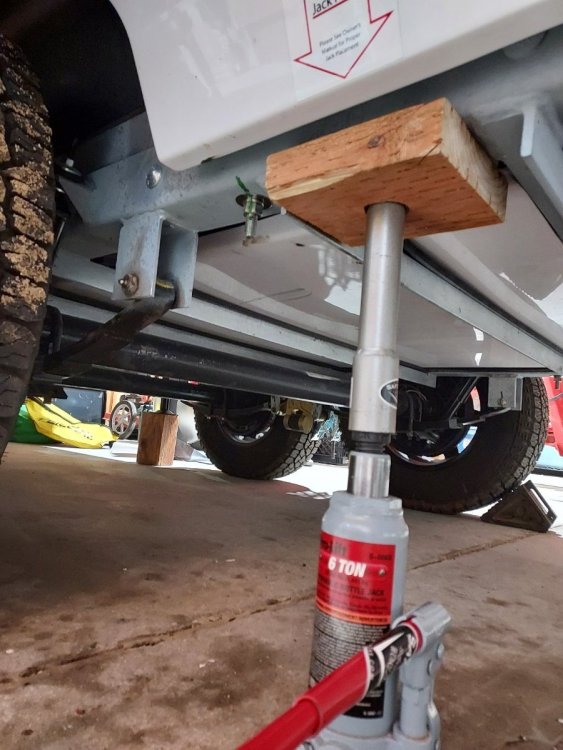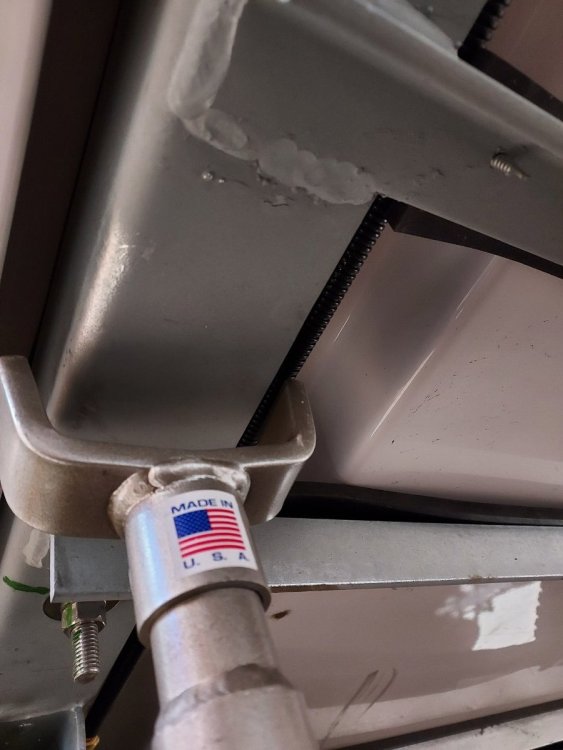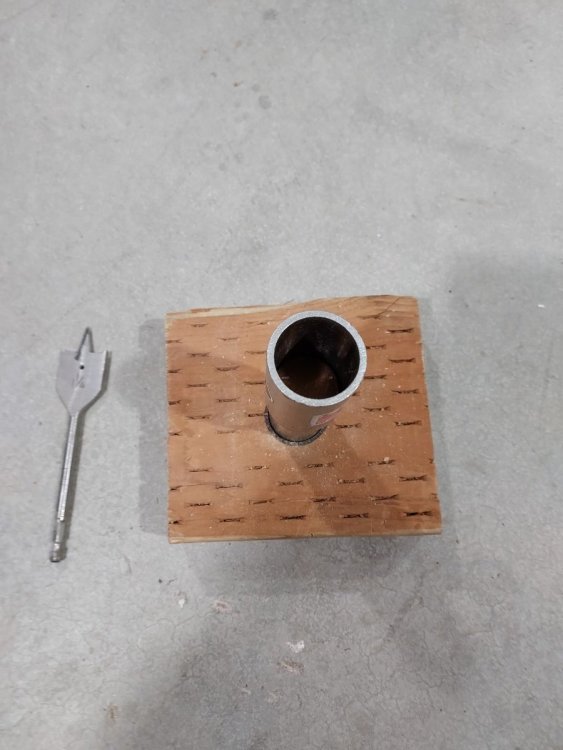-
Posts
905 -
Joined
-
Last visited
-
Days Won
17
Everything posted by Rivernerd
-
If you define "extended period" as 6 days, our experience towing our new Elite II home from Hohenwald to Idaho in mid-November is instructive. We used the Varioheat furnace for 6 straight sub-freezing nights in Arkansas, Oklahoma, New Mexico, Colorado, Utah and Idaho, 4 of them above 4000' elevation. The overnight low on three of those nights was in the teens, and 9 degrees F once (in Colorado). The Varioheat adequately heated the cabin with the CP Plus wall control set at 68 degrees F, and more important to us, kept the underbelly of the trailer where the tanks and water lines run, above 38 degrees F. It ran almost constantly at night, which we suspect is because the trailer is not all that well insulated. It consumed about 1.5 gallons of propane per night. We figured that our two 5-gallon propane tanks allowed us to safely heat for 5 nights without refill. The exterior walls remained cold and sweated a bit, but we do not blame the furnace for that. That is to be expected where, unlike in a home, the supply air ducts are in the middle of the heated space, not along the walls. We remained warm enough (and both my wife and I like to sleep warm, so we used sleeping bags), but because we could not get very far away from the exterior walls when sleeping , we did not feel "cozy." We believe one reason the Varioheat furnace system kept the underbelly at least a few degrees above freezing is the addition of a return air vent from the bathroom to the open area under the front dinette seat. There has been extensive discussion on another thread suggesting that additional return air ducting from the cabin into the underbelly area will help improve Oliver furnace system performance. See: As my wife and I did not purchase the Oliver for winter use, we find the Varioheat furnace adequate for our needs. We do not believe it is undersized. We were just happy that it performed well enough to get us home in reasonable comfort, given our mid-November delivery date and the colder-than-average temps we encountered!
-
Good catch. I suspect the reason for the "15 lbs. of liquid" notation is the class action suit Amerigas recently settled. See, e.g.: https://www.classlawgroup.com/amerigas-propane/ Instead of actually filling 20 lb. tanks, Amerigas opted to just specify the amount of underfill. Caveat emptor ("Buyer Beware").
-
John Davies addressed height in an earlier post. I will address garage door width. Wider is also better. Your situation sounds very similar to ours. 4 years ago we built a 30' x 30' outbuilding to house our tractor, raft trailer and inflatable boats. We call it the "boat shed." That is where we now store our Oliver Elite II, because it has 16'-high rafters and a 16'W x 12'H garage door. The tractor got moved elsewhere. Now that we store the 7'-wide Oliver and the 7'-wide raft trailer side by side in the boat shed, we wish the garage door were wider. When installed, the garage door opening is about 15'10". With about 6" clearance on each side of the door opening, there remains only about 10" between the sides of the two trailers when "perfectly" parked. It is workable, but in hindsight, we wish we had paid the extra for an 18'W garage door. It would make backing the second of the two trailers into the boat shed much less stressful, and make it easier to walk between them. For the 26'W building to house your "Oliver and a boat," if in doubt, get the wider garage door.
-

Leaking Propane Hoses to Regulator
Rivernerd replied to Wayfinder's topic in Mechanical & Technical Tips
It seems to me that the brass 90 built into the 12" replacement hoses you bought would reduce the stress on the hose connections, likely increasing the useful life of the assembly. Does anyone know why Oliver doesn't install 12" hoses with the brass 90's, instead of the longer hoses that must be bent into a tight curve to make that 90-degree turn from the tank to the regulator connection? -

SOLVED! Heater keeps shutting off
Rivernerd replied to Dave Mazone's topic in Mechanical & Technical Tips
This has happened to me with propane tanks not in my trailer. Easy to try and see if it works. -
As the owner of an Elite II with a 2-5/16" hitch towed with an Andersen WD hitch, I would not recommend it. We paid the premium to upgrade to a 2-5/16" coupler (we found no price differential between 2" ball Andersen kits and the ones with a 2-5/16" ball) precisely because we planned to tow with a 2019 Tundra, which requires the Andersen. I am a retired attorney, so I am sensitive to the liability and insurance coverage risks incurred when NOT following truck manufacturers' requirements. Given the experience reported by John Davies on this thread several years ago with a 2" ball/Andersen hitch combo, and the improvement to ball wear after he upgraded to a 2-5/16" ball, we felt the 2-5/16" coupler upgrade was a sensible precaution. Having now towed the Elite II about 2300 miles from Hohenwald to Idaho, I found a noticeable, but not severe, wear pattern on the 2-5/16" ball from the pressure applied by the Andersen. I believe, based on John Davies' experience, that the wear would have been much more marked with a 2" ball. Thus, the upgrade cost was worth it to us. BUT, based on the experience of those on this forum towing with 3/4 ton pickups, if we had a Silverado 2500 instead of a Tundra, we would not have bought an Andersen WD hitch, and would not have paid the premium for the 2-5/16" coupler upgrade. While an Andersen hitch may be recommended when towing with a 3/4 ton pickup, it is not REQUIRED as it is with our Tundra. And, without the Andersen WD hitch, your coupler/ball connection will not be subjected to the weight distribution force applied by the Andersen, thus you should have no abnormal ball wear issues with a 2" ball.
-
I am interested in the observations that led you to this conclusion. We tow an Elite II with a Tundra, so using the Andersen is required by Toyota, per the owner's manual. But many other posters on this forum who tow with 3/4 ton pickups, like the Silverado 2500, advise that they absolutely do not "feel the need" for a weight distribution hitch. What prompts you to "feel the need" for the Andersen hitch?
-
Mine are rated at 53db from 23 feet. I confirmed this with a basic db meter on my phone. The db level reads the same when running both as when running only one. I can live with that level for the couple of hours it takes to recharge batteries. Although hauling two inverter/generators takes more space in the bed of our Tundra, it is also easier for this old guy to lift and carry just one at a time. As a comparison, the new Honda eu3200i is rated at "54 to 58 db(A)".
-
Yes, in addition to the Truma Aventa AC, we have the Truma Varioheat furnace and the Truma Aquago water heater. They comprise the Truma upgrade package now offered by Oliver on 2023 models. Since the Truma Varioheat furnace is now standard on all Olivers, the "upgrade" part, for which a premium is charged, includes the Aventa AC and Aquago water heater components. We learned about the potential for the Truma AC upgrade from posts on this forum many months ago, so we asked our Oliver salesperson about it. We were advised that the AC upgrade came as part of a package, which required the Truma Aquago water heater as well. When we received our updated Deposit Receipt from Oliver which included the additional premium for the Truma upgrade, we learned that the $3800 upgrade also included the Truma Varioheat furnace. When we took delivery of the trailer, we saw that the packaging of those three Truma upgrades made sense: they are all centrally controlled by the Truma CP Plus wall control.
-
Since Oliver no longer recommends using the "stabilizer" jacks to jack up their trailers for tire changes, I invested in a bottle jack for that purpose. At John Davies' suggestion, I purchased an RV Safe Jack. My hope was that the Safe Jack would come with the components necessary to safely jack up an Oliver Elite II in a variety of situations, because you never know where you will need to change a tire. This post describes how I have chosen to use the RV Safe Jack on our Elite II, and includes a warning about using the u-shaped saddle that comes with the RV Safe Jack to jack up an Oliver at the specified jack point. The 6-ton RV Safe Jack includes three jack extensions: one 6" and two 3" extensions. Also included is a clever Extension Screw Collar, which can be placed on the extension screw on top of the bottle jack when it is extended. The Extension Screw Collar helps stabilize the interface between the extension and the screw. Only the 6” extension fits under the Oliver when jacking from a smooth surface (like a concrete floor). See first photo below. If you are changing a tire by the side of the road, and wind up with a hole right below the specified jack point, the other two 3" extensions may come in handy. Do not use the included u-shaped saddle on the steel frame at the specified jack point. It could crush the propane line (which is inside wire loom). See the second photo below. The saddle is designed for use when jacking under an axle, but Oliver recommends jacking from the steel-reinforced part of the frame, not under an axle. I had hoped the u-shaped saddle in the Safe Jack RV kit would fit around the steel reinforcement frame, securing the jack to the frame. But, alas, the copper propane line (protected by wire loom) is installed right next to the steel reinforcement frame, so using the u-shaped saddle to jack in that location is a definite "no go." Instead of the u-shaped saddle, I chose to use a 6” length of 2x6 lumber, with a 1-1/4” x ½” deep hole drilled with a spade bit. The block fits nicely between the two welded angle iron pieces of the steel reinforcement frame. The block also cushions the interface between the top of the extension and the steel frame. The 1-1/4" x 1/2" deep hole in the 2x6 block holds the jack extension in place, as shown in the first photo below. The third photo below shows my 6" length of scrap 2x6 with an extension inserted, and next to it, the 1-1/4" spade bit I used to drill the 1/2" deep hole. Hope this is helpful to anyone choosing to invest in the RV Safe Jack system for use on an Oliver.
-
Although it was hard to swallow the $3800 Truma upgrade cost (versus the $1500 cost of a RecPro, since we believed we would be o.k. with the Suburban water heater and furnace), we are now glad we have the Truma Varioheat furnace, the Truma Aquago water heater and the CP Plus wall control. The benefits of the Varioheat furnace, which we did not know were part of the package until we took delivery, include more robust ducting and a return air vent in the bathroom. Since we had to drive home to Idaho in sub-freezing temps, we were also glad we had the Truma antifreeze kit as part of that package. In hindsight, we feel we made the right choice for us, and received good value for the upgrade cost.
-
Yes. RecPro lists the 13.5KBTU unit as 47db on the low setting. Our Truma Aventa produces 48db on the "low" and "night" settings. Per Truma and Oliver's specs, a 3kw generator is required to run the Truma Aventa. But, as MnM notes above, whether a genset somewhat less powerful than 30000W will work is, as yet, unknown. Truma will not allow the installation of a MicroAir Easy Start unit, which is required to run an AC unit with only a 2kw generator. One of the tradeoffs for us when we committed to the Truma Aventa install upgrade was the purchase of a second Champion 2kw dual fuel inverter/generator, a Paralink kit and an ACME splitter for the extra propane tank, so the two combined units produce 4Kw starting power, with 3100 running watts on propane. So yes, there are tradeoffs.
-

Harvest Hosts locations cited for operating illegal campgrounds
Rivernerd replied to SNY SD UP's topic in General Discussion
It is no surprise to me that tax-driven enforcement measures are being taken in California. As the linked article states: "In the county’s eyes, hosts are not paying the appropriate transient occupancy taxes." -
I expect most of the cost is the Texas use tax. Use tax is the way states collect tax on vehicles purchased in another state. Since the "sale" occurs outside the state, Texas cannot collect "sales" tax. But, if you want to "use" your trailer, you must license it, so states with sales tax normally tax the "use" of the vehicle at the same rate as if it was purchased in the state. If you lived in a state with no sales tax (like Oregon), you would normally pay no use tax. When you buy a vehicle in another state (like Tennessee), you are not required to pay Tennessee sales tax. But, you must pay use tax in the state in which you title and license the vehicle, in your case, Texas. We were not surprised by our high Idaho title, use tax and licensing fees, because we knew we were bound to pay the use tax when we titled our Oliver.
-

elite 2 Trouble Winterizing the City Water Port step.
Rivernerd replied to Yvette D's topic in Mechanical & Technical Tips
It was. I encountered the same issue when winterizing our new Elite II a couple of weeks ago. I learned I had skipped a step. Try opening the cold external faucet valve, with the external faucet head button depressed and locked into the "on" position. Then pump. Once you see antifreeze coming out of the external faucet, stop pumping. There is no need to repeat with the hot water valve open. See the below video at 3:41. -
The 2020 Ram 3500 lists a payload capacity of up to 7680 lbs., depending on configuration. It would be interesting to know what the GVWR sticker on that truck says...
-

1 year service ; Coupler bent??!!!
Rivernerd replied to Karin's topic in Welcome To The Oliver Travel Trailer Forums
That is precisely why we did not order the front basket with our new Elite II. When I had a similar experience with my raft trailer 20+ years ago, I added a 3-foot straight section of steel to extend that trailer's A-frame tongue, then put a different coupler on it. Now when I have to jack knife that trailer, no bumper damage. Since I could not realistically add length to the Oliver tongue, we opted to forego the basket--and carry the stuff that could have been in the basket in the back of our Tundra tow vehicle. -
Did you verify which terminals are positive and which are negative before installing the replacement batteries?
-
It appears you have two 6-volt batteries wired in series (positive to negative) to create a 12-volt battery bank. The test procedure I detailed above won't work. I defer to those more knowledgeable about 6-volt systems to advise you regarding proper test procedures for those batteries.
-
Your AGM batteries can be checked for proper charge while connected to your Oliver. I assume they are 12-volt batteries. Place the red lead from a voltmeter on the positive terminal and the black lead on the negative terminal. If using a multimeter, ensure that it is set to read "DC Volts." It should read around 12.6V. If not, one or both may be defective. In that case, I would disconnect the batteries from the trailer and test them individually. If either battery separately reads less than 12.6V, I would connect a good quality battery charger that has an "AGM" mode to one of them and let it charge overnight, then re-read the voltage. Repeat with the other battery. If you can't get either battery to hold a charge of about 12.6V, with no loads connected, it is defective. The reasonably-priced NOCO Genius 5 charger linked below has an AGM mode. https://www.amazon.com/NOCO-GENIUS5-Fully-Automatic-Temperature-Compensation/dp/B07W8KJH44/ref=asc_df_B07W8KJH44/?tag=hyprod-20&linkCode=df0&hvadid=385121954544&hvpos=&hvnetw=g&hvrand=3750609399406645391&hvpone=&hvptwo=&hvqmt=&hvdev=c&hvdvcmdl=&hvlocint=&hvlocphy=9029558&hvtargid=pla-1041741797992&psc=1&tag=&ref=&adgrpid=76842158285&hvpone=&hvptwo=&hvadid=385121954544&hvpos=&hvnetw=g&hvrand=3750609399406645391&hvqmt=&hvdev=c&hvdvcmdl=&hvlocint=&hvlocphy=9029558&hvtargid=pla-1041741797992 Good luck!
-
I recommend the stainless steel spikes available through the link below: https://www.amazon.com/Spikes-Pigeons-Small-Stainless-Coverage/dp/B085CBNQFX/ref=asc_df_B085CBNQFX/?tag=hyprod-20&linkCode=df0&hvadid=475793236502&hvpos=&hvnetw=g&hvrand=11280687831360435102&hvpone=&hvptwo=&hvqmt=&hvdev=c&hvdvcmdl=&hvlocint=&hvlocphy=9029558&hvtargid=pla-1063130179122&psc=1 Why? We have an open truss design similar to your "winter home" on the front portico to our home. Those trusses have attracted nesting birds. We installed plastic bird spikes, like this: https://www.amazon.com/Deterrent-Outdoor-Pigeons-Squirrel-Outside-Brown/dp/B09WJVZ34X/ref=asc_df_B09WJVZ34X/?tag=hyprod-20&linkCode=df0&hvadid=598365509249&hvpos=&hvnetw=g&hvrand=11280687831360435102&hvpone=&hvptwo=&hvqmt=&hvdev=c&hvdvcmdl=&hvlocint=&hvlocphy=9029558&hvtargid=pla-1677722735497&psc=1 Last spring, a clever robin built her nest right on top of the plastic spikes, using them as structural support for the nest! So, next spring, I plan to replace the plastic spikes with stainless spikes. Lesson learned.
-
This aptly describes our experience with the Varioheat furnace in cold overnight temps, a few times at high altitudes, during our return journey to Idaho. With the door closed, the bathroom was nearly as warm as the main cabin, with main cabin temp at 68 F. Also, the street side plumbing areas got no colder than 27 degrees above outside ambient temperature. For example, when the outside overnight low was 9 degrees F, (with the main cabin temp at 68 F), the street side plumbing area next to the exterior faucet got no lower than 38 degrees F.
-
The Tire Minder also has the ability to monitor both the tow vehicle and all four tires on the trailer. You just need to buy enough TPMS sensors for all 8 wheels.
-
The Tire Minder TPMS system we recently purchased for the Elite II we picked up on November 10, 2022 was relatively easy to program. It performed well during our 2000+mile journey back to Idaho. With ambient temps ranging from the teens to the 50's F, we noted about a 3-PSI pressure increase from 50 PSI "cold" to 53 PSI "hot" as the tires warmed while on the road. It will be interesting to see what happens when towing in warmer temps, next spring.







